Duchess of Gloucester House
36 Ridgeway Road, Isleworth, Middlesex TW7 5LP
Medical dates:
Medical character:
Hostel (paraplegics)
The Duchess of Gloucester House
- a hostel for paraplegics - was officially opened in November 1949 by
the Duchess of Gloucester. Originally planned for war veterans,
it was intended to be a permanent home for paraplegics who could work
but who had no homes, or for those whose condition was such that they
could not live at home without nursing assistance.
The hostel, which had 70 beds, had been built on an 8-acre site which had once been occupied by three large manor houses. Although in a residential area, it lay within a short distance of many light industrial plants, such as Firestone Tyre and Rubber Co., Sperry-Rand and Pyrene Fire Extinguisher Co., and local employers cooperated in finding suitable work for the hostel's residents in nearby offices and factories.
The 2-storey administration building faced the roadway. It housed the Reception Centre, the administrative offices and the medical and service areas. At one end of the building a broad corridor extended towards the rear of site. A series of eight ward rooms projected from this corridor towards the same side in a finger plan. Each ward room could accommodate 8 people. Generous space was provided. At one end of the ward was a Day Room, with a library, radio and television. Each ward wing was provided with broad terraces, with a large outdoor court between each pair of wards, providing privacy and quiet.
On the opposite side of the corridor from the ward rooms were specially equipped toilets and sterilising rooms. At the end of the corridor nearest the administration building was a nurses' station, as well as two small isolation and treatment wards. A Medical Officer attended weekly.
The central dining room and food service area were located directly behind the administration building, and connected to it by a large lobby.
A modest-sized gymnasium at the far end of the ward wing was used for exercise, games, cinema shows and church services. The laundry and linen store were in a separate building. The site also contained a garage and a power plant. A separate special garage had enough space for 45 motorised vehicles for paraplegics. There was also a separate Nurses' Home.
Residents were encouraged to develop independence and mobility. They travelled to and from work - a distance varying from 1 to 12 miles - in three-wheeled motorised vehicles with special equipment. A wheelchair was left at the place of work for the individual's use. The hostel itself was specially equipped and constructed to enable the wheelchair-bound residents to be as mobile and independent as possible.
In 1953 the hostel, which had originally been administered by the Ministry of Pensions and National Insurance, transferred to the control of the Ministry of Labour and National Service (later known as the Department of Employment and Productivity). It became a centre for all paraplegics, admitting both ex-servicemen and civilians injured in industrial accidents.
By 1961 it had 80 beds, with 74 men accommodated in the main building and 6 women in the Nurses' Home. Most of the residents had been referred from the Spinal Injuries Centre at Stoke Mandeville Hospital in Aylesbury. A clinician from the Hospital attended periodically.
Most of the residents could care for their own needs without nursing assistance. Their daily schedule included sports, games and other recreation - darts and billiards - and educational programmes. The Hostel's staff included a Manager, an Assistant Manager, a Ward Master, 5 orderlies, 5 nurses and a non-technical staff of 28.
Each resident received an income of about £8 from the state and paid about £2.50 a week to the hostel. Capital budget and maintenance costs were paid by the Ministry of Labour.
Since the hostel had opened in 1949, some 231 paraplegics had been placed in employment and many had been able to leave after rehabilitation and had remained independent since.
By 1977 it was felt that the hostel was not providing the most satisfactory accommodation for the residents' needs. The government and the Manpower Services Commission decided that they could no longer justify the special provision. Arrangments were made to gradually rehouse the residents and the hostel closed in the 1980s.
Present status (January 2011)
The buildings have become Isleworth Crown Court.
The hostel, which had 70 beds, had been built on an 8-acre site which had once been occupied by three large manor houses. Although in a residential area, it lay within a short distance of many light industrial plants, such as Firestone Tyre and Rubber Co., Sperry-Rand and Pyrene Fire Extinguisher Co., and local employers cooperated in finding suitable work for the hostel's residents in nearby offices and factories.
The 2-storey administration building faced the roadway. It housed the Reception Centre, the administrative offices and the medical and service areas. At one end of the building a broad corridor extended towards the rear of site. A series of eight ward rooms projected from this corridor towards the same side in a finger plan. Each ward room could accommodate 8 people. Generous space was provided. At one end of the ward was a Day Room, with a library, radio and television. Each ward wing was provided with broad terraces, with a large outdoor court between each pair of wards, providing privacy and quiet.
On the opposite side of the corridor from the ward rooms were specially equipped toilets and sterilising rooms. At the end of the corridor nearest the administration building was a nurses' station, as well as two small isolation and treatment wards. A Medical Officer attended weekly.
The central dining room and food service area were located directly behind the administration building, and connected to it by a large lobby.
A modest-sized gymnasium at the far end of the ward wing was used for exercise, games, cinema shows and church services. The laundry and linen store were in a separate building. The site also contained a garage and a power plant. A separate special garage had enough space for 45 motorised vehicles for paraplegics. There was also a separate Nurses' Home.
Residents were encouraged to develop independence and mobility. They travelled to and from work - a distance varying from 1 to 12 miles - in three-wheeled motorised vehicles with special equipment. A wheelchair was left at the place of work for the individual's use. The hostel itself was specially equipped and constructed to enable the wheelchair-bound residents to be as mobile and independent as possible.
In 1953 the hostel, which had originally been administered by the Ministry of Pensions and National Insurance, transferred to the control of the Ministry of Labour and National Service (later known as the Department of Employment and Productivity). It became a centre for all paraplegics, admitting both ex-servicemen and civilians injured in industrial accidents.
By 1961 it had 80 beds, with 74 men accommodated in the main building and 6 women in the Nurses' Home. Most of the residents had been referred from the Spinal Injuries Centre at Stoke Mandeville Hospital in Aylesbury. A clinician from the Hospital attended periodically.
Most of the residents could care for their own needs without nursing assistance. Their daily schedule included sports, games and other recreation - darts and billiards - and educational programmes. The Hostel's staff included a Manager, an Assistant Manager, a Ward Master, 5 orderlies, 5 nurses and a non-technical staff of 28.
Each resident received an income of about £8 from the state and paid about £2.50 a week to the hostel. Capital budget and maintenance costs were paid by the Ministry of Labour.
Since the hostel had opened in 1949, some 231 paraplegics had been placed in employment and many had been able to leave after rehabilitation and had remained independent since.
By 1977 it was felt that the hostel was not providing the most satisfactory accommodation for the residents' needs. The government and the Manpower Services Commission decided that they could no longer justify the special provision. Arrangments were made to gradually rehouse the residents and the hostel closed in the 1980s.
Present status (January 2011)
The buildings have become Isleworth Crown Court.
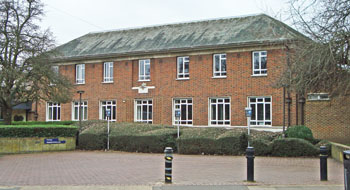
The former administration block.

A masonry plaque in the centre of the building denotes it was built in 1948 in the reign of King George VI.
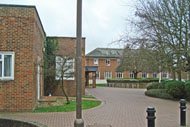
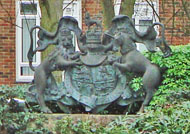
The former isolation wards have become the main entrance to the Court (right). A bronze coat-of-arms is located by the road entrance (left).
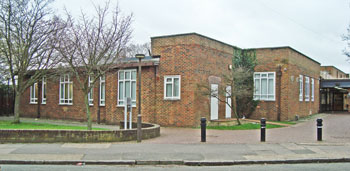
The former isolation wards.
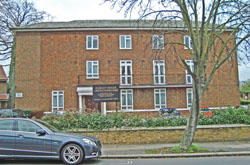
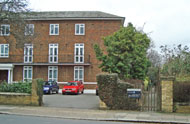
The former Nurses' Home is now the Dudley Nursing Home (left). A footpath to the Court runs beside it, but the gateway is locked (right).
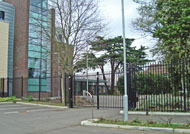

The old ward blocks (left) can be seen behind the extension to the Court, built in the 1990s (right).
Guttmann L 1954 Statistical survey of one thousand paraplegics. Proceedings of the Royal Society of Medicine 47, 1099-1103.
Guttmann L 1964 Rehabilitation and the paraplegic. Journal of the College of General Practitioners 8, 36-42.
http://democraticservices.hounslow.gov.uk
http://hansardmillbanksystems.com (1953)
http://hansardmillbanksystems.com (1977)
www.archive.org
www.britishpathe.com
www.theyworkforyou.com
www.veterans-uk.info
Return to home page